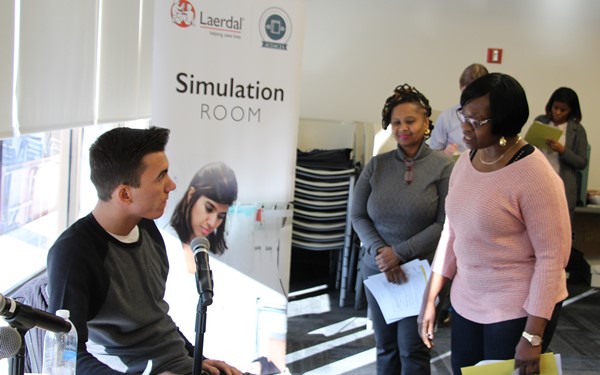Imagine having the opportunity to interact with a trained actor simulating nursing home residents with specific behavioral health challenges. Participants in the final learning exchange of the Labor Management Project’s (LMP’s) and Continuing Care Leadership Coalition’s (CCLC’s ) Behavioral Health Learning Collaborative (BHLC) had the chance to practice non-confrontational skills in a safe, controlled environment and learn strategies from one another for de-escalating challenging situations.
Angella Harvey, an experienced CNA at Amsterdam Nursing Home in Manhattan volunteered for the simulation and found it illuminating. “It was a real learning experience, seeing myself and how I would react. I demonstrated calm – it’s the norm for me not to react in these situations. I listen and try to understand what is going on with the resident.”
Other participants played the role of observers – of both the resident and caregiver – recording what they saw and receiving feedback from the facilitators.
Center for Medicare and Medicaid Services (CMS) regulations require that nursing home staff “must provide the necessary behavioral health care and services to attain or maintain the highest practicable physical, mental, and psychosocial well-being, in accordance with the comprehensive assessment and plan of care.” Last January, we reported on outcomes of LMP’s 2018 inaugural Behavioral Health Learning Collaborative (BHLC) that aimed to guide nursing homes in metro-New York on how to meet these CMS requirements.
The Behavioral Health Learning Collaborative of 2019 convened 1199SEIU union members and nursing home managers from 14 skilled nursing homes. In addition to seminars, the LMP worked with each nursing home to create initiatives to further person-centered care, reduce psychotropic medications, and address psycho-social health of residents. In December, BHLC convened for its final of four learning and exchange sessions.
Each nursing home shared presentations and posters illustrating their journey and outcomes of the year’s work. These included reductions in combative behavior, staff injury, and workers’ compensation claims. Among the practices employed were regular mood and behavioral evaluations completed on every shift, aromatherapy, music therapy, midnight snacks for wakeful residents, and space redesign.
Zenaida Abat, Associate Director of staff development at Amsterdam Nursing Home, reflected on her experience with two years of the learning collaborative. “This collaboration proves that management and the union can work together and make a difference in the care of our residents and our staff.”
Wendy Martinez, a member of 1199SEIU for 21 years and [title] at BronxCare Special Care Center, shared: “I thought I knew it all – every tactic for every population. Actually, I didn’t have all the techniques. I’m now more effective in my work.”
Jennifer Cross, Director of Recreational Therapy at BronxCare Special Care Center described the value of the BHLC. “Every time I leave a session, I feel motivated to implement some of the ideas that are shared. It makes you stretch. Hearing of the outcomes from other nursing homes is very inspiring.”
